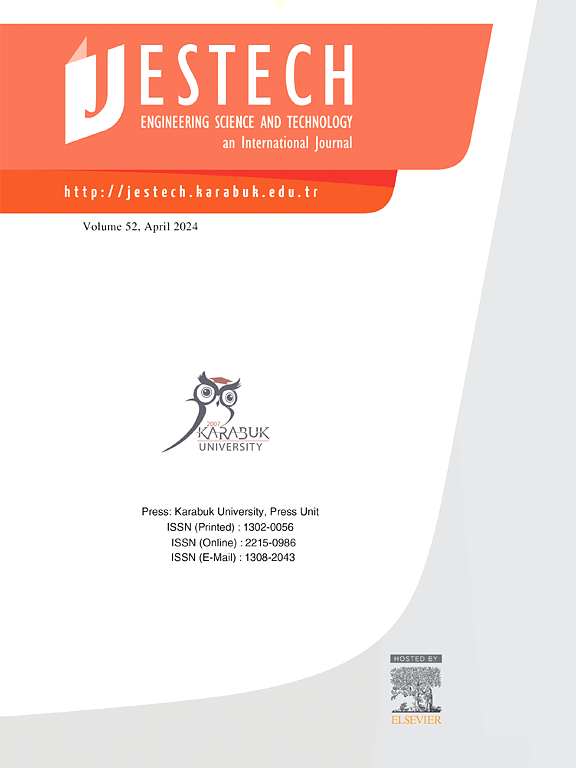Ciliary peristalsis flow of hydromagnetic Sutterby nanofluid through symmetric channel: Viscous dissipation in case of variable electrical conductivity
IF 5.1
2区 工程技术
Q1 ENGINEERING, MULTIDISCIPLINARY
Engineering Science and Technology-An International Journal-Jestech
Pub Date : 2025-02-01
DOI:10.1016/j.jestch.2025.101956
引用次数: 0
Abstract
For the sperm to have the best chance of reaching the egg, the ciliated walls of the uterine tube must be meticulously monitored. Recognizing the significance of this investigation, a novel mathematical simulation of this process has been performed by analyzing the dynamics of a non-Newtonian magnetized fluid adopting a Darcy flow framework with an undulating wall and an interior ciliated membrane. In the present investigation, the transmission of heat in a two-dimensional flexible conduit with ciliated walls of magnetic Sutterby nanofluids is investigated by considering all of these variables concurrently. Buongiorno’s nanofluid approach, that involves Brownian motion and thermophoresis aspects is considered. The channel is susceptible to ciliary wave motion, Joule heating effects, viscous dissipation, non-linear radiation flux, and other circumstances. The suspension’s electrical conductivity has been identified as a variable that is dependent on concentration distributions and the surrounding temperature. The problem-solving strategy depends on first transforming the system into a dimensionless form, after which using the lubrication approximation, the evolving boundary value problems has been normalized and linearized form. To carry out the numerical computations and produce graphical solutions, an appropriate algorithm is created and is referred to as the built-in command ND-Solve via computational software known as Mathematica. The most important findings pointed out that the gradients of the pressure are higher in the case of dilatant fluid comparing to the case of pseudoplastic fluid . Additionally, when the metachronal waves variable gets bigger, the peristaltic ciliary motility has a more optimal axial velocity than peristaltic flow along the walls within the entire area . The findings revealed a thorough grasp of biomimetic energy frameworks that utilize nanotechnology, magnetism, and ciliary peristalsis flow. Besides that, they provide a useful baseline for multi-physics simulations that are both experimental and numerical.
磁萨特比纳米流体通过对称通道的纤毛蠕动流动:变电导率情况下的粘性耗散
为了使精子有最好的机会到达卵子,必须仔细监测输卵管的纤毛壁。认识到这一研究的意义,通过分析采用达西流动框架的非牛顿磁化流体的动力学,采用波动壁和内部纤毛膜,对这一过程进行了新的数学模拟。在本研究中,同时考虑所有这些变量,研究了具有纤毛壁的磁性萨特比纳米流体的二维柔性管道中的热传递。布翁焦尔诺的纳米流体方法,涉及布朗运动和热泳方面的考虑。通道易受纤毛波运动、焦耳热效应、粘性耗散、非线性辐射通量和其他情况的影响。悬浮液的电导率已被确定为依赖于浓度分布和周围温度的变量。该方法首先将系统转化为无量纲形式,然后利用润滑近似将演化的边值问题归一化和线性化。为了进行数值计算并生成图形解,需要创建一个适当的算法,该算法被称为内置命令ND-Solve,通过称为Mathematica的计算软件。最重要的发现是膨胀流体(B>0)的压力梯度比假塑性流体(B<0)的压力梯度要大。此外,当变向波变大时,整个区域内纤毛蠕动运动的轴向速度比沿壁面蠕动流动更优[±0.5,±1]。研究结果揭示了利用纳米技术、磁性和纤毛蠕动流动的仿生能量框架的全面掌握。除此之外,它们还为实验和数值模拟的多物理场模拟提供了有用的基线。
本文章由计算机程序翻译,如有差异,请以英文原文为准。
求助全文
约1分钟内获得全文
求助全文
来源期刊

Engineering Science and Technology-An International Journal-Jestech
Materials Science-Electronic, Optical and Magnetic Materials
CiteScore
11.20
自引率
3.50%
发文量
153
审稿时长
22 days
期刊介绍:
Engineering Science and Technology, an International Journal (JESTECH) (formerly Technology), a peer-reviewed quarterly engineering journal, publishes both theoretical and experimental high quality papers of permanent interest, not previously published in journals, in the field of engineering and applied science which aims to promote the theory and practice of technology and engineering. In addition to peer-reviewed original research papers, the Editorial Board welcomes original research reports, state-of-the-art reviews and communications in the broadly defined field of engineering science and technology.
The scope of JESTECH includes a wide spectrum of subjects including:
-Electrical/Electronics and Computer Engineering (Biomedical Engineering and Instrumentation; Coding, Cryptography, and Information Protection; Communications, Networks, Mobile Computing and Distributed Systems; Compilers and Operating Systems; Computer Architecture, Parallel Processing, and Dependability; Computer Vision and Robotics; Control Theory; Electromagnetic Waves, Microwave Techniques and Antennas; Embedded Systems; Integrated Circuits, VLSI Design, Testing, and CAD; Microelectromechanical Systems; Microelectronics, and Electronic Devices and Circuits; Power, Energy and Energy Conversion Systems; Signal, Image, and Speech Processing)
-Mechanical and Civil Engineering (Automotive Technologies; Biomechanics; Construction Materials; Design and Manufacturing; Dynamics and Control; Energy Generation, Utilization, Conversion, and Storage; Fluid Mechanics and Hydraulics; Heat and Mass Transfer; Micro-Nano Sciences; Renewable and Sustainable Energy Technologies; Robotics and Mechatronics; Solid Mechanics and Structure; Thermal Sciences)
-Metallurgical and Materials Engineering (Advanced Materials Science; Biomaterials; Ceramic and Inorgnanic Materials; Electronic-Magnetic Materials; Energy and Environment; Materials Characterizastion; Metallurgy; Polymers and Nanocomposites)
 求助内容:
求助内容: 应助结果提醒方式:
应助结果提醒方式:


